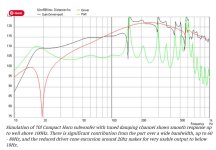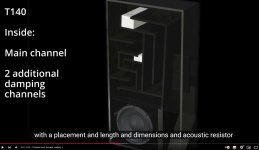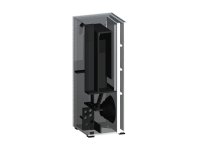Just stumbled upon the site from Kvålsvoll Design, and their Compact Subwoofer Horns.
https://www.kvalsvoll.com/Articles/CompactSubwooferTechnology.htm
Looks like very solid engineering.
Getting 110 dB @20 Hz from a 70 liter horn box. Not bad at all!
They are employing tuned "pipes" to dampen resonances, e.g. see the insides of the T140.
Like the shape of e.g. the V6, which would make a very good pedestal og lower part of a 3 way, with the V6 + say a 6.6-8 inch mid and a horn tweeter!
https://www.kvalsvoll.com/Articles/CompactSubwooferTechnology.htm
Looks like very solid engineering.
Getting 110 dB @20 Hz from a 70 liter horn box. Not bad at all!
They are employing tuned "pipes" to dampen resonances, e.g. see the insides of the T140.
Like the shape of e.g. the V6, which would make a very good pedestal og lower part of a 3 way, with the V6 + say a 6.6-8 inch mid and a horn tweeter!
Attachments
If you look at the graph of the system in a 70l enclosure it says 56Vrms ... this is about 400 W into 8 ohms
Not sure what power is needed for the T140 to reach 112 dB/20Hz .... you have to look a bit more for that 😉
But I think this is really not the point ... power is cheap today, and as they use Pro drivers, the needed power I think will be reasonable .. the point is taht you can get quite high spl from a relatively small box at low frequencies
Another cool feature of these designs is the use of tuned damping horn channels ..... look at how a resonance around 70 Hz is dampened by ca 10 dB
1m/2pi means free field, with the speaker standing on a plane/ground
Not sure what power is needed for the T140 to reach 112 dB/20Hz .... you have to look a bit more for that 😉
But I think this is really not the point ... power is cheap today, and as they use Pro drivers, the needed power I think will be reasonable .. the point is taht you can get quite high spl from a relatively small box at low frequencies
Another cool feature of these designs is the use of tuned damping horn channels ..... look at how a resonance around 70 Hz is dampened by ca 10 dB
1m/2pi means free field, with the speaker standing on a plane/ground
Last edited:
"Horn box" is a misnomer, the graph is from a simulation of the long port bass reflex enclosure, 70L would be the chamber volume, the port would occupy a similar volume. "the air volume inside the damped channel adds to the system internal volume".Looks like very solid engineering.
Getting 110 dB @20 Hz from a 70 liter horn box. Not bad at all!
The box is much larger than 70L.
At the Fb (box tuning) ~20Hz, the driver's excursion would be at minimum, nearly all the output from the port.
At 30Hz, the port contributes +6dB output to the direct radiator.
The excursion or SD of the driver is not specified.
Above 80 Hz, the port only contributes pipe resonances, those are damped by the tuned Helmholtz absorbers (dampers).Another cool feature of these designs is the use of tuned damping horn channels ..... look at how a resonance around 70 Hz is dampened by ca 10 dB
The T140 dimensions are 1140mm/620mm/284mm, 200L (7 cubic feet).Not sure what power is needed for the T140 to reach 112 dB/20Hz .... you have to look a bit more for that 😉
Most would consider that to be a fairly large bass reflex box for a 12" driver.
Kvålsvoll Designs big bass reflex boxes ("compact horns"...) probably don't require unreasonable power, I'd expect from the response of the V-Series the drivers reach Xmax in the 300-400 watt range.But I think this is really not the point ... power is cheap today, and as they use Pro drivers, the needed power I think will be reasonable ..
The SA 700 DSP amplifier for "Compact Horn subwoofers" Kvålsvoll Designs offers is rated for 2x 338W / 8 ohm which would be ~52volts..
Art
Attachments
"Horn box" is a misnomer,
Hard to see a horn anywhere in that box.
dave
It's an interesting and complex design. Leaves me wondering if there was a simpler way to get a usable response from 20 Hz to 100 Hz without any out of band vent resonances showing up in the response. A Dayton Audio RSS315HFA8 in an 3:1 offset-driver TL (133 L net) or something similar gets close ...

Well it was just meant as a bit of inspiration and food for thought .... ...... got me thinking anyways!
And of course all physics still apply. The pro scene are still using vented enclosures for all the subs .... hard to beat
For the T140, I think it does seem that the "port" does have some progression, thought yes it is could also maybe better be described as a flared transmission line ....
And of course all physics still apply. The pro scene are still using vented enclosures for all the subs .... hard to beat
For the T140, I think it does seem that the "port" does have some progression, thought yes it is could also maybe better be described as a flared transmission line ....
PS. From one of the videos, my best guess is that the 12" woofer used is the B&C 12NBX100, which s also a rather nice woofer with 4" VC .... but not the one you would normally pick for sub
Yes, the B&C 12NBX100 looks like the driver Kvålsvoll Designs uses:PS. From one of the videos, my best guess is that the 12" woofer used is the B&C 12NBX100, which s also a rather nice woofer with 4" VC .... but not the one you would normally pick for sub
The 12NBX100 has only 10mm Xmax, reaches that in a standard bass reflex of ~200L (gross) 20Hz Fb at only 37v, ~161 watts into the 8.6ohm impedance minima. The 12NBX100 is rated for 1000watts,lead wires woven through one of the two spiders, it could handle considerably more than 10mm excursion.
In this Hornresp sim, it does 110dB at 20Hz, similar to the V110 response level, other than the dip above Fb, which may not be as much as predicted:
With a Helmholtz absorber in the port, the pipe resonance ~110 Hz could be tamed.
Art
I'm getting a similar response curve in a smaller OD-TL tuned to 20 Hz. I'm curious as to why that particular driver was chosen though, as Fb is way lower than the driver's Fs.

I'm getting a similar response curve in a smaller OD-TL tuned to 20 Hz. I'm curious as to why that particular driver was chosen though, as Fb is way lower than the driver's Fs.
Øyvind Kvålsvoll's philosophy seems to favor the high BL, low mms woofer:
"Driver parameters for flat frequency response down low demands lower BL and higher moving mass, which unfortunately reduces efficiency at upper and mid bass frequencies, leading to compression and limited output capability in this important range.
By sacrificing efficiency at the lowest frequencies, but still have more efficiency higher up in frequency, one can have some of both - small size, and higher overall efficiency.
The shape of the frequency response will then fall off towards the low end, and will need equalizing. This is not a problem with subwoofers, as signal processing is required anyway."
The GD ~Fb is always near a wavelength in a bass reflex (1000/18.5Hz=54ms) or OD-TL.Consequence of such an alignment - high GD @fb. How audible that is @20 Hz though is another matter ...
We pay for resonant gain in time delay, that said, any musical signal with much output at 20Hz is also likely to have a fairly long decay, at least several wavelengths.
The upper pipe ringing ~39ms, over three wavelengths (1000/120Hz=8.3ms) in your sim is more of a problem, hence Kvålsvoll's use of Helmholtz dampers to reduce the ringing, (over 80ms at 80Hz in his group delay simulation!) "GD is now flat up to well above 100Hz."
Well, upper GD is flat in Kvålsvoll's simulation, but it still would be interesting to see what happens to GD/frequency response above the missing portion of his measurement graph:
As most manufacturers do, I'd expect the upper portion of the graph was cut off to avoid the "funk".
Art
Last edited:
The GD is influenced by the response around Fb as well. My previously posted example using another driver that's more suitable for a 20 Hz alignment shows less GD around 20 Hz.

And it also shows a near-flat GD around 80 Hz 🙂.
A dual-offset TL (as per the Bose patent) could deal with the impact of the resonance just above 100 Hz. I still have to find the time to put together a suitable BOXPLAN to design such a build, and the output would have to be an Akabak script as Hornresp can't model them.
And it also shows a near-flat GD around 80 Hz 🙂.
A dual-offset TL (as per the Bose patent) could deal with the impact of the resonance just above 100 Hz. I still have to find the time to put together a suitable BOXPLAN to design such a build, and the output would have to be an Akabak script as Hornresp can't model them.
Those resonances appear to be very sharp–far from well-damped. I guess "beauty" in this instance is in the eye of the beholder. It probably wouldn't be that difficult to get that sort of output from a 15-inch driver in a similarly compact sealed enclosure, without a plethora of resonances to dampen. On the face of it, it seems that the horn loading may be a suboptimal solution to an age-old problem.Getting 110 dB @20 Hz from a 70 liter horn box. Not bad at all!
They are employing tuned "pipes" to dampen resonances, e.g. see the insides of the T140.
I was looking for small tapped horn design on youtube and stumbled upon this last week. What a coincidence someone opened a thread about him. Fascinating designs for sure.
I'm getting a similar response curve in a smaller OD-TL tuned to 20 Hz. I'm curious as to why that particular driver was chosen though, as Fb is way lower than the driver's Fs.
View attachment 1471012
How are you getting that 12” driver to work in such a small tapered shape with the 50cm2 vent exit?
Edit: oops, nevermind, the input screen and loud speaker wizard are different
Some results from testing suggests around 7ms at 30-250Hz :How audible that is @20 Hz though is another matter ...
https://aaltodoc.aalto.fi/search?sp...uency group delay in a vented-box loudspeaker
"The audibility of low-frequency group delay distortion was studied using listening experiments and allpass filter models of the loudspeaker, as well as measured responses of actual loudspeakers. The equalization of the loudspeaker group delay distortion was found to be straightforward using modern DSP (Digital Signal Processing) techniques. However, the audibility of the group delay distortions was found to be quite dependent on the material reproduced, and the shorter delays are difficult to detect even by experienced listeners. Based on the listening test results the average detection level of group delay distortion in a vented-box type sound reproduction system at the frequency range of 30 to 250 Hz was estimated to be about 7 milliseconds."
- Home
- Loudspeakers
- Subwoofers
- Compact Horn Subwoofer Technology by Kvålsvoll Design




